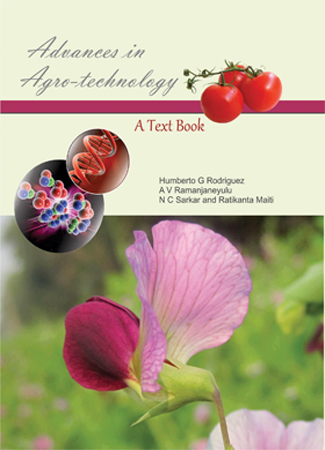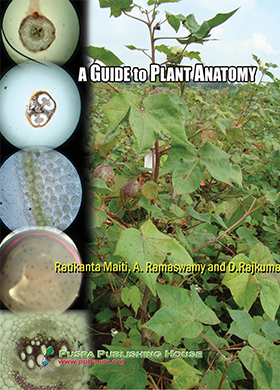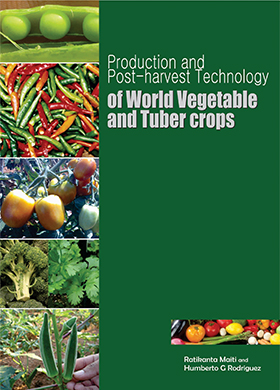Popular Article
Multifarious Uses of Vetiver Grass
A. V. Ramanjaneyulu, N. Sainath and M. Venkata Ramana
- Page No: 026 - 032
- Published online: 01 Jun 2021
-
Abstract
avr_agron@rediffmail.com
Vetiver grass has been recognized for stabilizing the lands susceptible to soil and water erosion thus conserves both the natural resources besides enhancing irrigation water quality. It is one of the best agrostological measures for protecting the contours. It has an exceptional ability to withstand extreme climatic conditions, sodicity and alkalinity. It is a good candidate for phytoremediation of polluted and contaminated soils. The oil extracted from its roots is widely used in industrial and medical fields. Overall, it is regarded as a dynamic tool for mitigating numerous environment and agriculture related challenges. Though a manual entitled “Vetiver Grass - A Hedge against Erosion (or known as ‘little green book’) by John Greenfield deals with technical aspects of it’s cultovation in detail, we made an effort to synthesize the available information on numerous applications of this soil binding grass and benefits in achieving sustainable agricultural development.
Keywords : Agriculture, economic uses, vetiver, soil and water conservation
-
Introduction
Vetiver grass is also known as khus. Its scientific name is Vetiveria zizanioides which is reclassified as Chrysopogon zizanioides. It is a perennial grass belonging to the family Poaceae. India is considered as the primary center of origin. It is generally found as wild plant throughout the tropical and sub-tropical plains, particularly along the river banks and in marshy lands. It can thrive on wide-ranging edapho-climatic conditions ranging from sandy seacoasts and swamps to plains and foothills and also on the hilltops up to 800m elevation in the Kumaun hills of Uttar Pradesh (Lavania, 2002). Tropical Asia, Africa, Australia, Haiti, Indonesia, Guatemala, India, China and Brazil are the main producers of vetiver grass. In India, while it is found as a wild grass in Punjab, Uttar Pradesh and Assam, it is systematically cultivated as a crop in Rajasthan, Uttar Pradesh, Kerala, Karnataka, Madhya Pradesh, Tamilnadu and Andhra Pradesh.
-
Unique Attributes of Vetiver
- Ø Vetiver produces a root system that is abundant, complex, extensive and vertical in nature. According to National Research Council (1993), the root grows almost straight down with few lateral surface roots. Thus it doesn’t interfere with the growth of other crops. It’s root system grows upto 3-4 m deep in the soil in the first year of plantingand attains a total length of 7 m after 36 months of planting. The roots are very strong with a mean tensile strength of between 75 and 85 MPa.
- Ø The leaves are thin and have sharp edges, while the shoots can grow up to 2 m in height. The mature foliage is tough and coarse. The crown of the plant occurs slightly below the soil surface. This architecture helps the plant avoid damage by grazing or trampling animals.
Ø The vetiver plant has the ability to tolerate extreme climatic variation such as prolonged drought, flood, submergence and extreme temperature from -14ºC to +55ºC. Further, vetiver survives for a short period even at –22ºC (-8ºF) in northern China. In Georgia (USA), vetiver survived in soil temperature of -10ºC, but not at –15ºC. Their roots undergo dormany at soil temperature of 5ºC
Ø It has quick rejuvenation capacity after being affected by climatic extremities like drought, frost, salinity and other adverse soil and environmental conditions.
- Ø Though it comes up well in well drained loamy soils, it has the ability to grow on soils with a pH ranging from 3.3 to 12.5 without the addition of soil amendments.
- Ø High level of tolerance to herbicides and pesticides.
- Ø It is identified as an efficient phytoremediation plant for absorption of N, P and heavy metals present in polluted water
- Ø Highly tolerant to Mg, Al, Mn and heavy metals such as As, Cd, Cr, Ni, Pb, Hg, Se and Zn in the soils
-
Types and Species of Vetiver
There are three types types of species in Vetiver system. Chrysopogon zizanioides and Chrysopogon lawsonii are originated in the Indian subcontinent. South Indian species have large and strong root system. They are polyploids and show high levels of sterility. They are not invasive and non-aggressive. Among South Indian types, Pusa Hybrid-7, Hybrid-8, CIMAPKS-2, Sugandha, KH-8, KH-40 and ODV-3 varieties available for commercial cultivation. Besides, Central Institute of Medicinal and Aromatic Plants (CIMAP), Lucknow developed and released cultivars like Dharini, Gulabi and Kesari. On the otherhand, the north Indian accessions present in the Gangetic and Indus basins, are wild and have weaker root systems. They are diploids and may or may not be invasive. North Indian types produce superior quality oil. Chrysopogon zizanioides used for research purpose in tropical and subtropical countries are of the Monto/Sunshine/Karnataka/Fiji/Madupatty genotype as they are sterile and can’t become weeds. Chrysopogon zizanioides grows taller and possess thicker and strong stems, deeper root system and broader leaves with light green area along the mid ribs. The third species Chrysopogon nemoralis are distributed in the highlands of the countries Thailand, Laos, Vietnam, Cambodia and Myanmar. This species is not sterile.There is another rare species Chrysopogon nigritana native to Southern and West Africa, which produces viable seeds.
-
Propagation
Though Vetiver can be propagated through tillers and slips, slips (Figure 1) are the best mode of propogation as they take short time for multiplication than that of tillers. The tops of the slips are cut before planting to curtail transpiration loss and ensure their survival chances. The slips are planted in pits, five to eight cm deep made with a pointed stick. One hectare requires 1,50,000 to 2,25,000 slips with 2 - 3 slips per pit. Vetiver can be planted during April to August, the best planting time to get higher oil yield under South Indian conditions is June-July. Generally, the slips are planted at a spacing of 45cmx30cm.
-
Nutrition
A fertilizer dose of 100 kg N, 40 kg P2O5 and 40 kg K2O ha-1 is recommended for Vetiver, with application of 40 kg N, 40 kg P2O5 and 40 kg K2O ha-1 as basal during last ploughing followed by 20 kg N ha-1 as top dressing at 4 months after planting during first year and 40 kg N ha-1 during second year.
-
Oil Production
On an average one hectare of vetiver plantation yields 3.0-4.5 tones of dry roots which on steam distillation yield 12 to 20 kg of oil. Globally, vetiver oil is produced at the rate of 250 tons per annum with maximum contribution from Haiti, Indonesia (only Java) and Reunion. India produces only 20-25 tons oil per annum with the highest quantity of oil from Uttar Pradesh, but, consumes 100 tonnes. The vetiver oil produced from North India is considered as the best oil and fetches a very high price (Rs. 30,000 to 58,000 kg-1) in the international market. The sequential steps in oil extraction from Vetiver grass roots is detailed in Figure 2.
-
Multifarious Uses
All parts of Vetiver grass are useful as each and every part is being used for different purposes. It was widely recognised as a bioengineering technique for steep slope stabilization, wastewater disposal, phytoremediation of contaminated land and water and other environmental protection purposes due to its multifarious uses as furnished below.
7.1. Agriculture
Ø Vetiver grass is an useful plant in dryland Agricuture. It is extremely hardy and can tolerate submergence and also withstand drought.
Ø The close growing culms slows water’s flow velocity (5 meters second-1), reduce rainfall runoff by 70% and sediment loss by 90% (Figure 3). Thus, it stabilizes and protects the soil against erosion. Thus, growing this grass for 3-4 cycles is recommended for improving the capacity of sandy soils to produce crops profitably
Ø Their roots increase soil macroporosity, thus, water infiltration rate leading to increased accessibility of plants to moisture and reduces evaporation, thus protects soil moisture under hot and dry conditions thus reduces crop failure
Ø Vetiver mulch also protects the soil against splash erosion
Ø This grass can be intercropped with other plantations to improve soil structure and stability, avoid soil erosion and increase field’s permeability to water and nutrients leading to enhanced growth and higher crop productivity
Ø Vetiver compost contains major nutrients i.e. N, P, K, Ca, and Mg with a pH of 7.0.
Ø Its shoot biomass is safe for animal feed in both fresh and dry forms as it retains all the absorbed contaminants, especially heavy metals in its roots (Panichpol et al., 1996)
Ø It is nutritious and high yielding grass as compared to other tropical and subtropical pasture grasses
Ø It can also protect fields against pests and weeds
Ø It is used as an anti-termite insecticide
Ø Vetiver leaves are used as a medium for mushroom cultivation since it contains cellulose, hemicellulose, lignin and crude proteins
7.2. Industry
Ø Due to fibrous properties of the stems and roots, it useful for handicrafts, ropes, mats, baskets, fans, sachets, window coverings, wall hangings, lampshades and ornaments
Ø Vetiver grass is popularly used as a roof thatch as it lasts longer than other materials (Grimshaw, 2002). It is also used in mud brick-making for housing construction as such bricks will have lower thermal conductivity.
Ø It is also used as a green fuel, cement replacement building material and vetiver-clay composite storage bin
Ø Straw bales are used in building construction (Pease, 2002)
Ø In Senegal, artisans are making pottery by mixing chipped vetiver mixed with clay, giving the finished non-fired product a nice earthy texture
Ø Vetiver can be used as a raw material for making pulp and paper
Ø The oil extracted from roots has persistent fragrance and is used in the manufacture of perfumes, agarbathis, aromatherapy, herbal skincare and ayurvedic soaps, cosmetics, and pan masala
Ø It is an important ingredient in some of the world’s best-known perfumes and soaps
Ø In India, vetiver essence is used to flavor a soft drink (Sharbat), syrup and ice cream
Ø The ethanol produced from vetiver is clear in color with a slight pleasing odor (Kuhirun and Punnapayak, 2000)
7.3. Ornamental
Ø Grown as a hedge (Pease, 2002)
Ø It is an aesthetically beautiful barrier
Ø Vetiver is also grown in pots to be used as a decorative potted plant (Juliard, 2002).
Ø A bundle of cut vetiver leaves can be used in bouquets
Ø Vetiver is a beautiful ornamental plant for gardens, patios, decks, etc.
7.4. Medicinal
Ø Vetiver roots and leaves can be used in therapeutics treatments (Simon, 2003)
Ø It has meidicinal properties and was found to be effective against prostate cancer, diabetes, hernia, incontinence, stomach and skin problems
Ø Vetiver is used for treating arthritis, rheumatism and a chin, stiff muscles.
Ø Relieves tension and chronic pain
7.5. Miscellaneous
Ø In the hilly regions of Karnataka, India, people made use of vetiver roots to prepare refreshing drinking water, ‘Nam YaFaek’, a Thai traditional beverage (Chomchalow and Hicks, 2001).
Ø A thick and permanent hedge of vetiver can act as an excellent barrier to prevent dust and heat
Ø The left over roots after oil extraction is used in making cartons and handicrafts items like mats, aasa (for sitting), pen stand etc.
Ø A tasty and best health sharbat (syrup) can be prepared by using water obtained during distillation
Ø Oil is used in the manufacture of scented toiletries as fixative
Ø Oil also can be used as flavour agent in food industry
The diversified uses of vetive grass are shown in a flow chart given below in Figure 4.
-
Conclusions and Future Perspectives
Vetiver grass is an ideal plant in Agriculture for protecting the soil and water resources besides environment. There is a need to educate the farmers about numerous direct and indirect benefits of vetiver cultivation. In view of its economic, environmental and social benefits in rural parts of the world, the genotypes suitable for various purposes like soil and water conservation, industry and ornamental purpose must be bred and made available for reaping maximum benefits from it’s cultivation.
Reference
-
Chomchalow, N., Hicks, A., 2001. Health potential of Thai traditional beverages. Assumption University Journal of Technology 5: 20-30.
Grimshaw, R., 2002. Vetiver Grass for Thatching. In: Vetiver Network Discussion Board, 13 January, 02.
Juliard, C., 2002. Vetiver Grass as an Ornamental Decorative Plant. In: Vetiver Network Discussion Board, 11 February, 02.
Kuhiran, M., Punnapayak, H., 2000. Leaves of vetiver grass as a source of ethanol. An abstract of a poster paper presented at 2nd International Conference on Vetiver (ICV-2), Phetchaburi, Thailand, 18-22 January.
Lavania, U.C., 2002. Primary and secondary centres of origin of vetiver and its dispersion. In: Chomachalow, N. and Barang, M. (Eds.), Proceedings of IInd International Conference on Vetiver: Vetiver and Environment, Royal Development Projects Board, Bangkok, Thailand, 424-426.
National Research Council, 1993. Vetiver Grass: A thin green line against erosion. Washington, D.C., National Academy Press, 169.
Panichpol, V., Waipanya, S., Siriwongse, M., 1996. Analysis of chemical composition of Vetiveria zizanioides Nash for using as feedstuff. In: Abstracts of papers presented at IIIrd International Conference on Vetiver (ICV-3), 4-8 February, Chiang Rai, 141.
Pease, M., 2002. Strawbales. In: Vetiver Network Discussion Board, 23 February, 02.
Simon, N., 2003. Medicinal vetiver. Proceedings of the IIIrd International Conference on Vetiver and Exhibition, 6-9 October, Guangzhou, China, 543-544.
Cite
Ramanjaneyulu, A.V., Sainath, N., Ramana, M.V. 2021. Multifarious Uses of Vetiver Grass . Chronicle of Bioresource Management. 5,1(Jun. 2021), 026-032. DOI:.
Ramanjaneyulu, A.V.; Sainath, N.; Ramana, M.V. Multifarious Uses of Vetiver Grass . CBM 2021,5, 026-032.
A. V. Ramanjaneyulu, N. Sainath, and M. V. Ramana, " Multifarious Uses of Vetiver Grass ", CBM, vol. 5, no. 1, pp. 026-032,Jun. 2021.
Ramanjaneyulu AV, Sainath N, Ramana MV. Multifarious Uses of Vetiver Grass CBM [Internet]. 01Jun.2021[cited 8Feb.2022];5(1):026-032. Available from: http://www.pphouse.org/cbm-article-details.php?cbm_article=25
doi = {},
url = {},
year = 2021,
month = {Jun},
publisher = {Puspa Publishing House},
volume = {5},
number = {1},
pages = {026--032},
author = { A V Ramanjaneyulu, N Sainath , M Venkata Ramana and },
title = { Multifarious Uses of Vetiver Grass },
journal = {Chronicle of Bioresource Management}
}
DO -
UR -
TI - Multifarious Uses of Vetiver Grass
T2 - Chronicle of Bioresource Management
AU - Ramanjaneyulu, A V
AU - Sainath, N
AU - Ramana, M Venkata
AU -
PY - 2021
DA - 2021/Jun/Tue
PB - Puspa Publishing House
SP - 026-032
IS - 1
VL - 5
People also read
Scientific Correspondence
Crop Residue Management in Cotton
A. V. Ramanjaneyulu, B. Ramprasad, N. Sainath, E. Umarani, Ch. Pallavi, J. Vijay and R. JagadeeshwarCotton residue, burning, pollution, management, multicrop shedder
Published online: 04 Mar 2021
Popular Article
Liquid Nano-Urea: An Emerging Nano Fertilizer Substitute for Conventional Urea
K. Lakshman, M. Chandrakala, P. N. Siva Prasad, G. Prasad Babu, T. Srinivas, N. Ramesh Naik and Arjun KorahLiquid Nano Urea, Nano technology, Nutrient use efficiency
Published online: 28 Jun 2022
Popular Article
Broomrape (Orobanche sp.) Management in Indian Mustard
Tanmay Das, Teekam Singh and Prakash SonnadBroomrape, mustard, parasitic weeds
Published online: 28 Mar 2023
Popular Article
Black Rice Cultivation in India – Prospects and Opportunities
Sanjoy Saha, S. Vijayakumar, Sanjana Saha, Ashirbachan Mahapatra, R. Mahender Kumar and R. M. SundaramAnthocyanin, Black rice, Forbidden rice, Nutritional value, Prospects
Published online: 27 May 2022
Demography and Dynamics of Commonly Harvested Woody Species in A Protected Forest Reserve-Western Zimbabwe
J. MudekweDemography, species, population, conservation, expanding, declining
Published online: 07 Jun 2017



.jpg)
.jpg)






